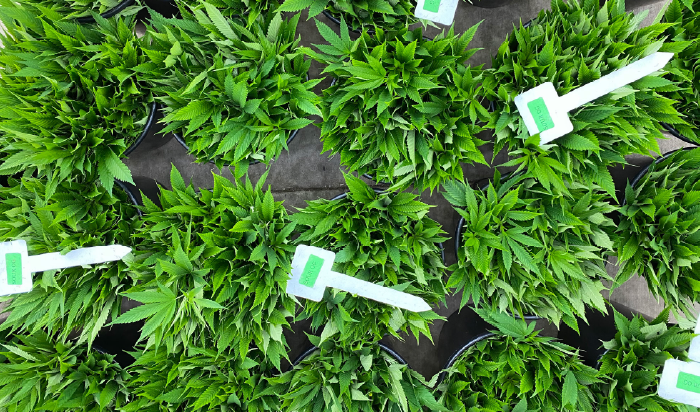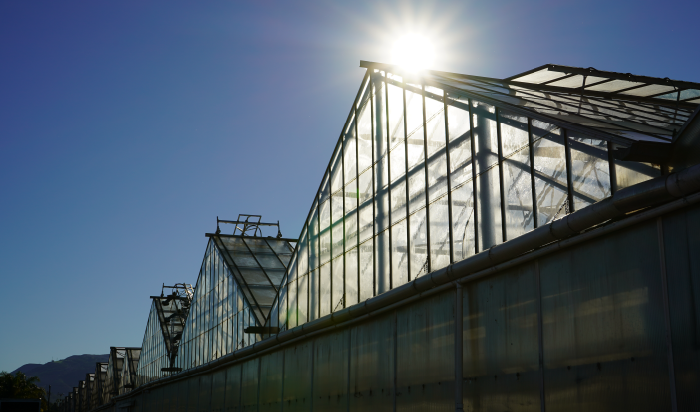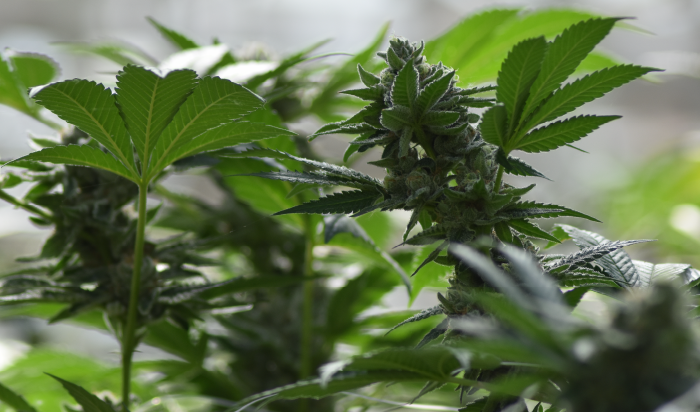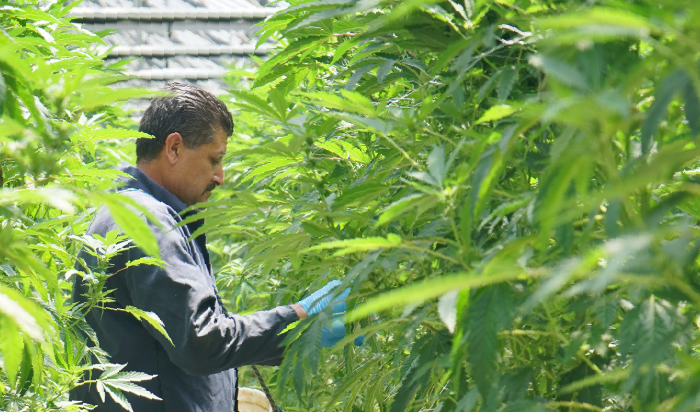Our Growing Practices
At Pacific Stone, we take great pride in our growing practices. Everything we do stems from our desire to grow high-quality cannabis while making it affordable for our customers. Here are some of the ways we’re growing fresh, sustainable cannabis.
Written By: The Pacific Stone Editorial Team
Date Published: October 16, 2023

Utilizing Clones
There are two main ways to start the cannabis growing process. One way is to utilize seeds. However, our process involves clones. Cloning is the process of taking a cutting from a female cannabis plant and growing an exact genetic copy of the original plant. Since all cannabis products come from female plants, we only take cuttings from females. Clones allow for a more consistent product while shortening the entire growing process.
Speaking of consistency, 100% of our plant propagation happens right on-site. We can tell you where each new plant comes from – because it comes from us. We can ensure a quality product all year because we have complete control of the strains we grow.

Greenhouse Grown
Cannabis can grow in multiple environments, and each has its advantages. While some may produce cannabis entirely outdoors, others may produce it entirely indoors. At Pacific Stone, we utilize a greenhouse system to get the best of both worlds. But our greenhouse isn’t small: we grow in roughly 20 acres of greenhouse!
As multi-generational Dutch greenhouse growers, we know how to harness the power of the greenhouse to produce a consistent crop. Here are some of the most significant advantages of growing cannabis in a greenhouse:
- Natural sunlight provides a more sustainable light source than electric lights
- Natural sunlight produces a full and flavorful terpene profile
- Protected against external factors like unpredictable droughts, poor soil conditions, wind, rains, and some pests
- Climate-controlled for a year-round growing season and always fresh product
- The stable growing environment produces a more consistent product, no matter the season
- The improved efficiency of greenhouse growing leads to better production
Contaminant Free
In California, the Department of Cannabis Control requires each batch of cannabis to be tested before it gets sold at a retail shop. Labs run these Certificate of Analysis (COA) tests. Not only are these tests to determine the THC, CBD, terpenes, and other cannabinoid content in the product, but they’re also testing to ensure that the cannabis is free from contaminants such as residual pesticides, mold, heavy metals, and other chemicals.
At Pacific Stone, our commitment to high-quality cannabis comes through in every action we take. That’s why we don’t cut corners. So, how do we protect each crop we grow from these contaminants? By simply not using them. When we say we know exactly what’s going into each pouch, we mean it.

Environmentally Conscious Practices
One of the reasons we love greenhouse growth for our cannabis is sustainability. While utilizing the sun as our light source is one way we care for the environment, we’ve put other environmentally conscious growing practices into place, including:
- Closed-loop irrigation system – recycling the tailwater from our hydroponic irrigation system reduces our water and fertilizer usage by 50%.
- Utilize coconut husk as a growing substrate – once we harvest our cannabis plants, we send the coco growing substrate to local avocado orchard farmers for mulch.
- Implement beneficial insects – these insects help us control harmful pests on the plants while boosting biodiversity in the greenhouse.
Boost yields with CO2 – We use a water boiler when heating the greenhouse. As a byproduct of this heating process, it produces carbon dioxide. We reuse this carbon dioxide with over 100 miles of pipe that delivers it to our plants.

The Growing Cycle
We produce fresh cannabis all year, thanks to our regimented growing cycle and climate-controlled greenhouse. Now that you’ve seen more about our growing practices, here’s what our complete growing cycle looks like:
Step 1: Cloning
In this first phase, we take cuttings from a healthy female cannabis plant and then re-plant these cuttings. Since it’s an identical genetic copy, we know what to expect from the cuttings. Therefore, we produce a consistent strain with genetically identical characteristics. So whether you buy a strain from us this week, next month, or next year, it will have the same characteristics.
Step 2: Planting
Next, we pot our strongest clones with coco growing substrate. In this step, we utilize a mix of nutrients to give the plants everything they need to grow healthy throughout the process.
Step 3: Vegetation
In the vegetative state, the roots and foliage of the plant start to develop substantially. During this time, we regulate the amount of light the plants receive, with 18 total hours of sunlight (supplemented by artificial light when necessary) per day.
Step 4: Flowering
The flowering state is the last stage of cannabis growth; in this phase, buds will begin to grow and reach their full maturation. Mature buds will produce sticky, milky white trichomes. During the flowering cycle, our plants receive 12 hours of natural light daily. In seasons with long days, we utilize blackout screens to control the amount of sun the plants receive.
Step 5: Harvest
Once it’s time to harvest, our year-round labor crew gets to work. We cut the plants and then transport them to our in-house drying facility. Because we have a year-round labor crew, we can uphold a high standard with each harvest.
Step 6: Hang Dry
Next, we hang dry our cannabis plants. We use dry trimming to produce a high-quality product with a flavorful, complete terpene profile. After harvesting the plants, they are hung in our in-house drying facility for one week. During this time in our temperature- and humidity-controlled facility, we reduce the plant’s moisture content as quickly as possible. The plants lose up to 70% of their harvest weight at this stage. We believe this process yields the best aroma and flavor possible.
Step 7: Cure
During the curing process, the whole plants spend several weeks in bins in our on-site curing facility. Like our dry rooms, the curing rooms are temperature- and humidity-controlled. Curing is an important part of the process, as it ensures a uniform moisture level throughout the plant while also helping plants retain their cannabinoids. Dry trimming helps produce a high-quality product with a flavorful, complete terpene profile. Once the plants have been cured, the flowers are bucked off the stocks, trimmed, and sorted.
Step 8: Quality Assurance
At Pacific Stone, we have a strict grading system in place to ensure that only the highest quality product makes it to our customers. To this end, our year-round staff inspects and grades every piece of the product.
We use large buds for all our flower products while grinding up smaller flower to make our pre-rolls. We use sugar shake in our roll-your-own packages, and we use trim for manufactured products.
Step 9: Packaging
Once we sort our product, it moves into packaging. Whether it’s flower, pre-rolls, blunts, roll-your-own joints, or slims, you can trust that you’re getting the best product possible without shortcuts. So if you see a Pacific Stone product, you know you’re getting the best we offer for the best price.
We’re proud of our growing practices and our commitment to producing sustainable, high-quality, and fresh cannabis all year round.
Ready to experience the Pacific Stone difference for yourself?

About Pacific Stone
Pacific Stone was founded in 2015 with the goal of growing clean, consistent, and affordable cannabis for California. Founded by friends and family from the 805, Pacific Stone is a labor of love. We are intently focused on delivering high-quality marijuana at an affordable price.
As multi-generational Dutch greenhouse growers, we utilize our long history of growing to bring you farm-direct cannabis at the best price all year long. We take pride in ensuring customer satisfaction, and our flower has been consistently recognized as some of the highest quality and top-selling throughout the state of California.



